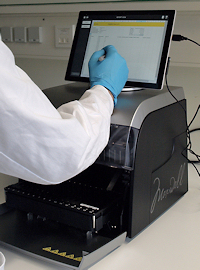Laboratory
Our research is mainly based on membrane transporters that we usually measure in cell culture after recombinant expression.
 |
 |
 |
Our cloning experiments usually start with tissue homogenization and automated RNA isolation. Then, quantity and quality of the RNA is thoroughly monitored.
 |
After transcription into cDNA, qualitative or quantitative PCR experiments are performed and amplification is controlled by agarose gel electrophoresis. Additionally, real-time PCR is used for mRNA expression analysis. |
 |
 |
The membrane carriers of interest are stably transfected into cell lines such as HEK293 or HepG2.
 |
 |
Overall, we possess more than 100 stably carrier-transfected cell lines that are cryoconserved in liquid nitrogen.
 |
The recombinantly expressed membrane transporters are analyzed by Western Blot or fluorescence microscopy. |
 |
 |
Some experimental setups require previous centrifugal separation or precipitation of particular cell compartments. |
|
Qualitative and quantitative transport experiments then are performed by liquid scintillation counting (in case of radiolabeled compounds) or by fluorescence detection (in case of fluorescently labeled compounds). |
 |
 |
 |
Quality of the radiolabeled compounds is constantly monitored by thin layer chromatography, and protein quantification allows normalisation of our transport data. |
 |
 |
Composition and pH of any buffer as well as absolute amount of any analyte are carefully defined and checked to allow the utmost level of accuracy, reliability and reproducibility of the transport experiments.
 |
The triple-quadrupole liquid chromatography UPLC-MS/MS system (U/HPLC, Nexera XS; MS/MS, AB Sciex API 4000) is used for quantitative monitoring of a wide variety of substances and drugs. The system is equipped with a highly selective and sensitive mass spectrometer (MS/MS), which can be utilized with ESI ionization techniques.



